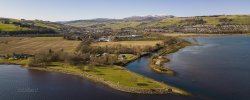I don't have one, really.
With the drone I almost always shoot bracketed, either AEB for single shots or manually for spherical panoramas.
If I won't be able to use HDR exposure-blending, I use the histogram and zebra stripes to adjust the exposure. And then still use AEB because I'm also flying and with my old eyes it's easy to miss something on that small display!
For my panoramas I usually shoot 1/8000, 1/2000, 1/500, and so on — six stops between exposures. Sometimes I only need two brackets to capture enough dynamic range, sometiems I need four or more — really depends on the scene and where the sun is in the sky.
Here is a pretty good explanation of what David was saying.
Exposing to the right, or ETTR, is an approach to photography that is as helpful as it is controversial. On one hand, exposing to the right is yet another technique to remember while shooting, and it can potentially ruin your exposure if utilized incorrectly.

photographylife.com
This is the kind of shot I usually do with my drone, for which ETTR isn't much use:
360° panorama photo from Canada by Robert Prior. Gibsons is a lovely town on British Columbia’s Sunshine Coast, famous as the location "The Bea...

www.360cities.net













